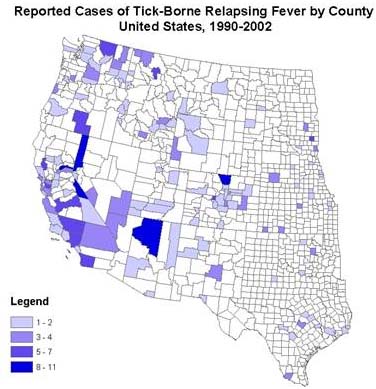Relapsing fever epidemiology and demographics
|
Relapsing fever Microchapters |
|
Diagnosis |
|---|
|
Treatment |
|
Case Studies |
|
Relapsing fever epidemiology and demographics On the Web |
|
American Roentgen Ray Society Images of Relapsing fever epidemiology and demographics |
|
Risk calculators and risk factors for Relapsing fever epidemiology and demographics |
Editor-In-Chief: C. Michael Gibson, M.S., M.D. [1]
Overview
Epidemiology and Demographics
TBRF is endemic in the western US, southern British Columbia, plateau regions of Mexico, Central and South America, the Mediterranean, Central Asia, and much of Africa. The first endemic focus of TBRF in the US was identified in 1915 in Colorado (Meader 1915) though the first case was actually in 1905 in New York in a traveler to Texas. Since then, TBRF has been reported in 14 states: Arizona, California, Colorado, Idaho, Kansas, Montana, Nevada, New Mexico, Ohio, Oklahoma, Oregon, Texas, Utah, Washington, and Wyoming.
Most recent cases and outbreaks have occurred in rustic cabin or vacation home settings at higher elevations (> 8,000 feet) in coniferous forests in the western US (Banerjee, Banerjee et al. 1998; Trevejo, Schriefer et al. 1998; Paul, Maupin et al. 2002; Centers for Disease and Prevention 2003; Schwan, Policastro et al. 2003).
TBRF normally occurs in summer months when people are traveling to mountainous areas on vacation. TBRF can, however, occur in winter, particularly when people go into rodent infested cabins and start fires, warming the cabin and producing carbon dioxide and warmth that attract the ticks that transmit TBRF.

Reporting of TBRF
Although TBRF was removed from the list of nationally notifiable conditions in 1987, 11 states require TBRF to be reported to their State Health Departments (Arizona, California, Colorado, Idaho, Nevada, New Mexico, Oregon, Texas, Utah, Washington, and Wyoming). Other states such as Montana, may institute reporting in the future. [1]
